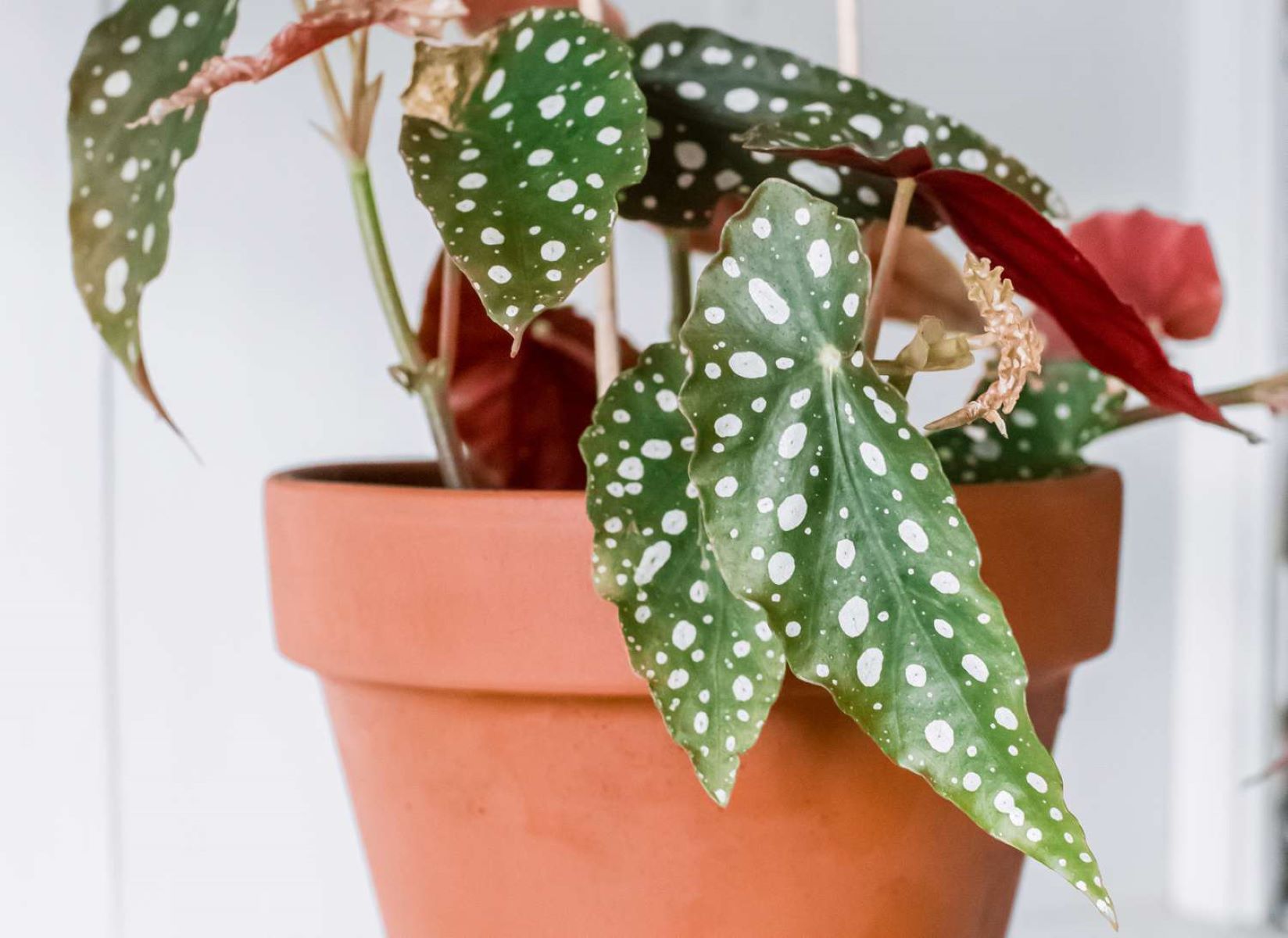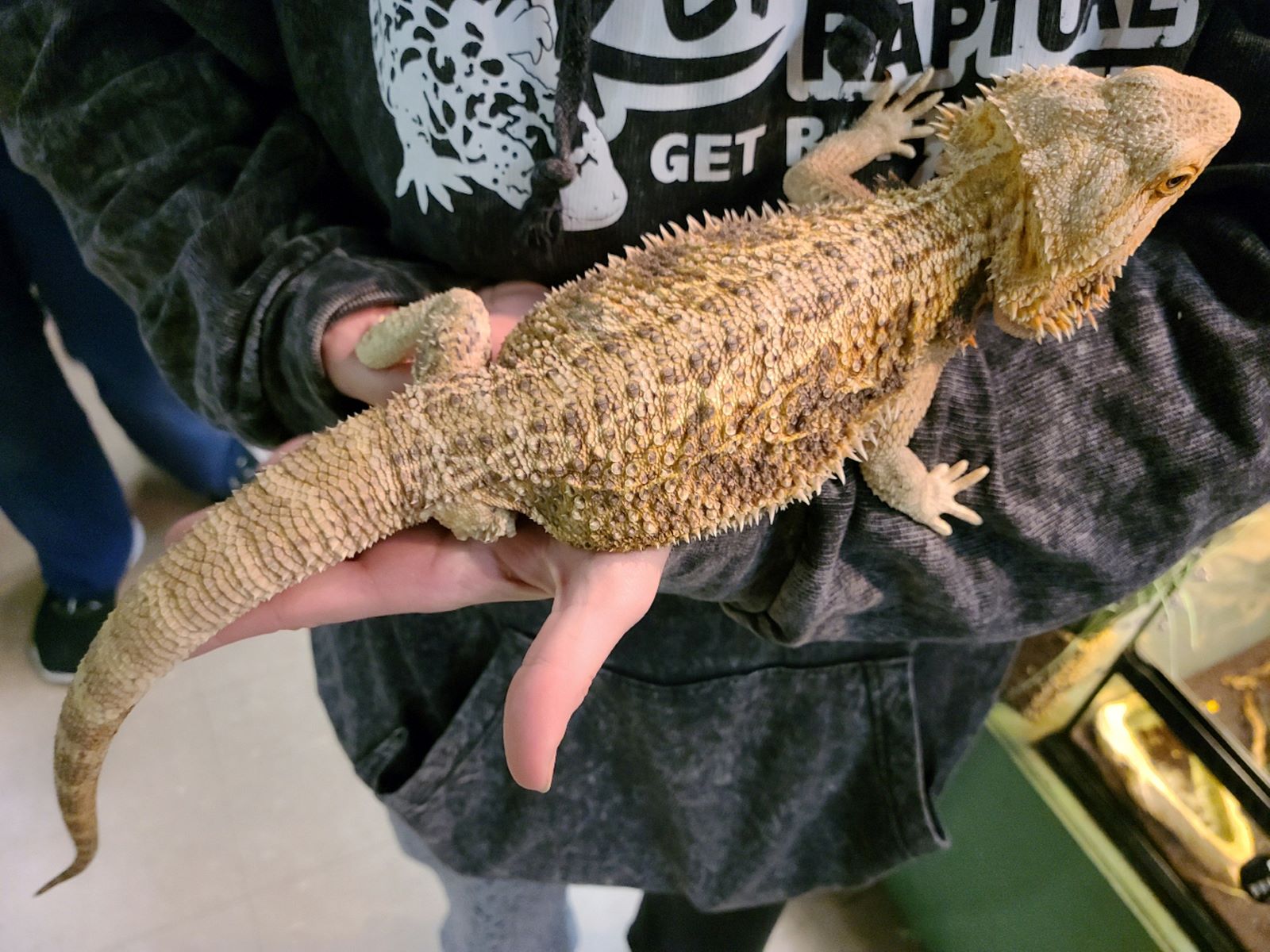Home>Lifestyle>The Ultimate Guide To Caring For Your Angel Wing Begonia Plant – Unleash Its Full Potential!


Lifestyle
The Ultimate Guide To Caring For Your Angel Wing Begonia Plant – Unleash Its Full Potential!
Published: February 16, 2024
Discover the essential tips for nurturing your Angel Wing Begonia plant and watch it thrive in your lifestyle. Unleash its full potential with our ultimate care guide!
(Many of the links in this article redirect to a specific reviewed product. Your purchase of these products through affiliate links helps to generate commission for Regretless.com, at no extra cost. Learn more)
Table of Contents
Introduction
Welcome to the ultimate guide to caring for your Angel Wing Begonia plant! If you're an avid plant enthusiast or a beginner looking to nurture a stunning and vibrant indoor plant, you've come to the right place. Angel Wing Begonias are renowned for their striking foliage, delicate flowers, and relatively low-maintenance nature, making them a popular choice for both seasoned gardeners and those new to plant care.
In this comprehensive guide, we'll delve into the various aspects of caring for Angel Wing Begonias, from understanding their unique characteristics to providing the optimal growing conditions. Whether you're looking to unleash the full potential of your existing Angel Wing Begonia or contemplating adding one to your plant collection, this guide will equip you with the knowledge and skills needed to ensure the health and vitality of your beloved plant.
Throughout this guide, you'll discover the specific light requirements that Angel Wing Begonias thrive in, the best watering practices to keep them hydrated and happy, the ideal temperature and humidity levels to maintain, the suitable soil and potting techniques, as well as the art of fertilizing for optimal growth. Additionally, we'll explore the essential techniques of pruning and propagation to help your Angel Wing Begonia flourish.
Furthermore, we'll address common pests and diseases that may affect your plant and provide valuable insights into how to prevent and manage these issues effectively. Lastly, we'll delve into enhancing the beauty of your Angel Wing Begonia, allowing you to showcase its full splendor within your living space.
By the end of this guide, you'll be equipped with the knowledge and expertise to nurture your Angel Wing Begonia with confidence, enabling it to thrive and bring joy with its radiant presence. So, let's embark on this rewarding journey of nurturing and celebrating the remarkable beauty of Angel Wing Begonias!
Understanding Angel Wing Begonia
Angel Wing Begonias, scientifically known as Begonia coccinea, are renowned for their enchanting foliage and delicate flowers, making them a captivating addition to any indoor garden. This species is characterized by its distinct wing-shaped leaves, which often display striking patterns and vibrant colors, ranging from deep green to silver and burgundy. The foliage's asymmetrical, angelic appearance lends the plant its poetic name, "Angel Wing Begonia."
These begonias are native to the tropical regions of South and Central America, where they thrive in the dappled shade of the forest understory. Their natural habitat provides valuable insights into their preferred growing conditions, making it easier for plant enthusiasts to recreate a suitable environment for them indoors.
Angel Wing Begonias are classified as cane-stemmed begonias, indicating that they develop tall, bamboo-like stems that support their luscious foliage. When grown in optimal conditions, these plants can reach impressive heights, adding a vertical dimension to indoor spaces and creating a visually striking display.
One of the most captivating features of Angel Wing Begonias is their delicate flowers, which bloom in clusters and come in an array of hues, including shades of pink, red, and white. These charming blooms add a touch of elegance and grace to the plant, further enhancing its allure.
In addition to their aesthetic appeal, Angel Wing Begonias are relatively low-maintenance, making them an ideal choice for both novice and experienced plant enthusiasts. Their adaptability to indoor environments, coupled with their forgiving nature, makes them a popular choice for those seeking a rewarding and visually stunning plant to nurture.
Understanding the unique characteristics and natural habitat of Angel Wing Begonias is crucial for providing them with the care they need to thrive. By delving into the intricacies of these remarkable plants, we can gain valuable insights into their specific requirements, enabling us to create an environment that allows them to flourish and unleash their full potential.
Light Requirements
Angel Wing Begonias thrive in bright, indirect light, making them well-suited for indoor environments. When it comes to light requirements, these begonias prefer a balance between sunlight and shade. Ideally, they should be placed in a location that receives bright, filtered light for a significant portion of the day. This can be achieved by positioning them near a north- or east-facing window, where they can benefit from gentle morning sunlight without being exposed to the harsh, direct rays of the afternoon sun.
It's important to avoid placing Angel Wing Begonias in areas with intense, direct sunlight, as this can lead to leaf scorching and dehydration. While they appreciate ample light, prolonged exposure to direct sun can be detrimental to their overall health and vitality. Therefore, finding the right balance is essential for ensuring their well-being.
In indoor settings, it's advisable to observe the plant's response to its current location. If the leaves appear to be reaching towards the light source or showing signs of sunburn, it may indicate that the begonia is receiving too much direct sunlight. On the other hand, if the plant exhibits leggy growth or a lack of vibrant foliage, it could be a sign that it needs more light.
For those who are unable to provide bright, filtered light, supplemental artificial lighting can be utilized to meet the plant's requirements. LED grow lights or fluorescent fixtures positioned at an appropriate distance can effectively supplement natural light, ensuring that the begonia receives the necessary light spectrum for photosynthesis and growth.
Understanding and meeting the light requirements of Angel Wing Begonias is crucial for promoting healthy foliage, vibrant blooms, and overall plant vigor. By providing the ideal lighting conditions, enthusiasts can create an environment where these captivating plants can thrive and reveal their full splendor.
In summary, the key to successful light management for Angel Wing Begonias lies in finding the perfect balance of bright, filtered light and ensuring that the plant is shielded from intense, direct sunlight. By carefully observing the plant's response and making necessary adjustments, enthusiasts can create an optimal environment that allows their Angel Wing Begonias to flourish and thrive.
Watering
Proper watering is essential for the health and vitality of Angel Wing Begonias. These plants have specific moisture needs, and understanding how to water them effectively is crucial for their overall well-being. When it comes to watering, it's important to strike a balance, ensuring that the plant receives adequate hydration without being subjected to waterlogged conditions that can lead to root rot and other complications.
Angel Wing Begonias thrive in moderately moist soil, and the key to successful watering lies in maintaining consistent moisture levels while allowing the soil to dry out slightly between waterings. Before watering, it's advisable to check the top inch of the soil to assess its moisture content. If the soil feels dry to the touch, it's an indication that the plant is ready for watering.
When watering your Angel Wing Begonia, it's important to do so thoroughly, ensuring that water penetrates the entire root ball. However, it's equally crucial to allow any excess water to drain freely from the pot, preventing water from accumulating in the saucer or at the bottom of the container. This practice helps prevent waterlogging, which can lead to root suffocation and fungal issues.
The frequency of watering will depend on various factors, including the environmental conditions, pot size, and the plant's growth stage. During the active growing season, typically spring through early fall, Angel Wing Begonias may require more frequent watering to support their growth and blooming. Conversely, in the dormant phase during late fall and winter, the watering frequency should be reduced to accommodate the plant's reduced metabolic activity.
In addition to regular watering, it's important to consider the water quality when caring for Angel Wing Begonias. These plants are sensitive to chemicals found in tap water, such as chlorine and fluoride, which can be detrimental to their health. To mitigate this, allowing the water to sit for 24 hours before use can help dissipate these chemicals, or alternatively, using filtered or rainwater can provide a suitable alternative.
Understanding the specific watering needs of Angel Wing Begonias and implementing a consistent watering routine is essential for promoting healthy growth, vibrant foliage, and prolific flowering. By striking a balance and providing the ideal moisture levels, enthusiasts can ensure that their Angel Wing Begonias thrive and flourish, adding a touch of natural beauty to their indoor spaces.
Temperature and Humidity
Maintaining the ideal temperature and humidity levels is paramount for the well-being of Angel Wing Begonias. These plants thrive in environments with consistent temperatures ranging from 65°F to 75°F (18°C to 24°C). It's essential to protect them from sudden temperature fluctuations and drafts, as these can stress the plants and compromise their overall health. During the winter months, it's crucial to shield them from cold drafts and ensure that they are not exposed to temperatures below 60°F (15°C).
In addition to temperature considerations, humidity plays a vital role in the successful cultivation of Angel Wing Begonias. Given their tropical origins, these plants favor environments with moderate to high humidity levels. Indoor spaces often have lower humidity, especially during the winter when heating systems can further reduce moisture levels. To address this, enthusiasts can employ various strategies to increase humidity around their begonias.
One effective method is to use a humidifier to maintain optimal moisture levels in the surrounding air. This not only benefits the begonias but also creates a more comfortable environment for occupants. Alternatively, placing the plant pots on trays filled with water and pebbles can create a localized humid microclimate around the plants, helping to mitigate the effects of dry indoor air.
Misting the foliage of Angel Wing Begonias can also provide temporary relief from low humidity, although it's essential to avoid excessive misting, as this can lead to fungal issues. Regularly monitoring the plant's foliage for signs of dryness or stress can help enthusiasts gauge the effectiveness of their humidity-boosting efforts.
By prioritizing the maintenance of suitable temperature and humidity levels, enthusiasts can create an environment that closely mimics the begonias' natural habitat, promoting robust growth, lush foliage, and prolific flowering. Understanding and addressing these environmental factors are key to nurturing healthy and vibrant Angel Wing Begonias, allowing them to thrive and flourish in indoor settings.
Soil and Potting
The selection of appropriate soil and potting methods is fundamental to the well-being of Angel Wing Begonias. These plants thrive in well-draining, nutrient-rich soil that provides a stable foundation for their growth and development. When it comes to soil composition, a blend of peat moss, perlite, and organic matter, such as compost or well-rotted manure, creates an ideal growing medium for these begonias. This combination ensures adequate aeration and moisture retention while offering essential nutrients to support their vitality.
In terms of potting, selecting a suitable container is equally important. Opt for pots with drainage holes to prevent water from accumulating at the root level, which can lead to root rot and other moisture-related issues. Additionally, choosing a pot that allows for ample room for root expansion is crucial, as it accommodates the begonia's growth and prevents overcrowding.
When repotting Angel Wing Begonias, it's recommended to do so during the active growing season, typically in the spring. This allows the plants to adjust to their new containers and encourages healthy root development. During the repotting process, gently loosen the roots and remove any old or decaying material before transferring the begonia to its new container with fresh soil.
Moreover, it's essential to position the plant at the same depth as it was in its previous container, ensuring that the crown remains slightly above the soil level to prevent rot. Once repotted, water the begonia thoroughly to settle the soil and encourage the establishment of the plant in its new environment.
Understanding the significance of soil composition and potting practices enables enthusiasts to create an optimal growing environment for their Angel Wing Begonias. By providing a nutrient-rich, well-draining soil mixture and employing proper potting techniques, enthusiasts can facilitate healthy root development and overall plant vigor, setting the stage for their begonias to thrive and reveal their full splendor.
In summary, the careful selection of soil components and conscientious potting practices are essential for nurturing robust and flourishing Angel Wing Begonias. By prioritizing these foundational aspects, enthusiasts can establish an environment that supports the plants' growth and vitality, allowing them to showcase their stunning foliage and delicate blooms within indoor spaces.
Fertilizing
Fertilizing plays a pivotal role in nurturing the health and vibrancy of Angel Wing Begonias, providing essential nutrients that support their growth and flowering capabilities. When it comes to fertilization, it's important to adopt a balanced and strategic approach, ensuring that the begonias receive the necessary elements to thrive without the risk of over-fertilization, which can be detrimental to their well-being.
During the active growing season, which typically spans from spring to early fall, Angel Wing Begonias benefit from regular fertilization to fuel their growth and encourage prolific blooming. A water-soluble, balanced fertilizer with a formulation such as 20-20-20 or 10-10-10 provides a suitable blend of essential nutrients, including nitrogen, phosphorus, and potassium, which are vital for the plants' overall development.
Enthusiasts should aim to fertilize their Angel Wing Begonias every two to four weeks during the growing season, diluting the fertilizer to half or quarter strength to prevent the risk of fertilizer burn. This cautious approach ensures that the plants receive the necessary nutrients without overwhelming their delicate root systems.
It's important to apply the fertilizer to damp soil to facilitate even distribution and prevent potential root damage. Carefully following the manufacturer's instructions regarding application rates and frequency is crucial, as it helps maintain a balanced and controlled fertilization regimen.
In contrast, during the dormant phase in late fall and winter, fertilization should be scaled back to accommodate the reduced metabolic activity of the begonias. Ceasing fertilization during this period allows the plants to undergo a natural resting phase, preparing them for renewed growth in the upcoming spring.
Furthermore, enthusiasts can consider incorporating organic fertilizers, such as compost or well-rotted manure, into the soil mix during the repotting process. This organic matter provides a slow-release source of nutrients, enriching the soil and promoting long-term vitality.
By adhering to a well-structured fertilization schedule and employing a cautious and balanced approach, enthusiasts can provide their Angel Wing Begonias with the essential nutrients needed to thrive. Fertilization serves as a cornerstone of their care regimen, enabling these captivating plants to flourish and reveal their full potential, adorned with lush foliage and abundant, delicate blooms.
Pruning and Propagation
Pruning plays a crucial role in maintaining the health, appearance, and overall vitality of Angel Wing Begonias. Regular pruning not only helps control the plant's size and shape but also encourages new growth, enhances flowering, and prevents the onset of disease. When approaching the task of pruning, it's essential to do so with care and precision, ensuring that the begonias benefit from the process without being subjected to unnecessary stress.
The first step in pruning Angel Wing Begonias involves the removal of spent or fading flowers. This practice, known as deadheading, not only promotes a tidy and aesthetically pleasing appearance but also redirects the plant's energy towards producing new blooms. By snipping off the faded flowers at the base of their stems, enthusiasts can stimulate the begonias to continue flowering, prolonging the display of their delicate and colorful blossoms.
In addition to deadheading, the removal of leggy or overgrown stems can help maintain the begonias' shape and encourage bushier growth. When pruning, it's advisable to make clean cuts just above a leaf node using sharp, sterilized pruning shears. This technique promotes new growth at the point of pruning and prevents the risk of damage or infection. By selectively trimming back unruly or excessively long stems, enthusiasts can sculpt the begonias into visually appealing and well-proportioned specimens, enhancing their overall allure within indoor spaces.
Propagation offers enthusiasts an opportunity to expand their collection of Angel Wing Begonias and share the beauty of these plants with others. One of the most common methods of propagation involves taking stem cuttings, which can be rooted to create new, independent plants. To propagate Angel Wing Begonias via stem cuttings, enthusiasts should select healthy, non-flowering stems and snip them just below a leaf node using a clean, sharp blade. The cuttings can then be placed in a suitable growing medium, such as a mix of perlite and peat moss, and kept consistently moist until roots develop. This method allows enthusiasts to create new plants from established specimens, further enriching their indoor garden with the captivating presence of Angel Wing Begonias.
By incorporating regular pruning into their care routine and exploring the rewarding practice of propagation, enthusiasts can actively engage with the growth and development of their Angel Wing Begonias. These techniques not only contribute to the plants' well-being but also offer a fulfilling and hands-on approach to nurturing these remarkable specimens, fostering a deeper connection with the captivating world of indoor gardening.
Common Pests and Diseases
Angel Wing Begonias, while relatively resilient, are susceptible to certain pests and diseases that can compromise their health and vigor. By familiarizing themselves with these potential challenges, enthusiasts can take proactive measures to prevent and manage these issues effectively, safeguarding the well-being of their beloved plants.
Common Pests:
-
Spider Mites: These tiny arachnids are a common nuisance for indoor plants, including Angel Wing Begonias. They thrive in dry conditions and can cause stippling and webbing on the foliage. Regularly misting the plant and maintaining adequate humidity levels can deter these pests.
-
Mealybugs: Recognizable by their white, cottony appearance, mealybugs are sap-sucking insects that can weaken the plant and excrete honeydew, leading to sooty mold. Manual removal and targeted insecticidal treatments can help control infestations.
-
Aphids: These small, soft-bodied insects can cluster on the tender growth of Angel Wing Begonias, causing distortion and yellowing of leaves. Insecticidal soaps or horticultural oils are effective in managing aphid populations.
-
Scale Insects: Identified by their protective, waxy shells, scale insects can attach themselves to stems and leaves, draining the plant of vital fluids. Pruning infested areas and applying horticultural oil can aid in scale control.
Common Diseases:
-
Powdery Mildew: Characterized by a powdery white coating on the leaves, powdery mildew thrives in humid conditions. Improving air circulation and avoiding overhead watering can help prevent this fungal disease.
-
Botrytis Blight: Also known as gray mold, this fungal disease can affect the foliage and flowers, causing them to become discolored and decay. Proper ventilation and avoiding excessive moisture can mitigate the risk of botrytis blight.
-
Root Rot: Excessive moisture, poor drainage, or overwatering can lead to root rot, causing the plant's roots to decay. Adjusting the watering regimen and ensuring well-draining soil can prevent this damaging condition.
-
Bacterial Leaf Spot: This disease presents as dark, water-soaked spots on the leaves, eventually leading to tissue decay. Pruning affected foliage and avoiding overhead watering can aid in managing bacterial leaf spot.
By remaining vigilant and promptly addressing any signs of pest infestations or disease development, enthusiasts can protect their Angel Wing Begonias from potential harm. Regular inspections, proper sanitation practices, and swift intervention when issues arise are essential for maintaining the health and beauty of these captivating plants.
Remember, a proactive approach to pest and disease management is key to fostering thriving and resilient Angel Wing Begonias, allowing them to flourish and enrich indoor spaces with their stunning foliage and delicate blooms.
Enhancing the Beauty of Your Angel Wing Begonia
Elevating the visual appeal of your Angel Wing Begonia goes beyond basic care; it involves creative strategies to showcase its captivating features and integrate it seamlessly into your living space. Here are several approaches to enhance the beauty of your Angel Wing Begonia:
Creative Display:
Embrace creativity by selecting aesthetically pleasing containers that complement the begonia's foliage and flowers. Consider decorative pots or hanging baskets that accentuate the plant's unique characteristics while adding a touch of elegance to its presentation.
Companion Planting:
Pairing your Angel Wing Begonia with compatible houseplants can create visually appealing arrangements. Opt for companions that complement its color palette and growth habits, such as ferns, ivy, or other begonia varieties, to create harmonious and eye-catching indoor landscapes.
Stylish Accents:
Incorporate decorative elements, such as natural stones, colorful pebbles, or miniature figurines, around the base of the plant to add a personalized touch to its surroundings. These accents not only enhance the visual allure but also contribute to the overall ambiance of the space.
Artful Pruning:
Explore creative pruning techniques to sculpt the begonia's growth, creating unique shapes or patterns that accentuate its natural form. Tasteful pruning can transform the plant into a living work of art, adding an element of individuality to its appearance.
Seasonal Decor:
Embrace seasonal themes by incorporating seasonal decorations or themed accessories around the begonia. This approach allows for dynamic visual transformations, ensuring that the plant remains a focal point throughout the year.
Illumination:
Strategically position the begonia in well-lit areas to highlight its vibrant foliage and delicate blooms. Consider utilizing soft, ambient lighting to create captivating silhouettes and shadows, adding an enchanting dimension to its visual impact during the evening hours.
By implementing these creative strategies, you can elevate the beauty of your Angel Wing Begonia, transforming it into a captivating centerpiece within your home or office. Embracing artistic expression and thoughtful design not only enhances the plant's visual appeal but also fosters a deeper appreciation for its natural splendor, allowing it to radiate its full potential in your indoor space.
Conclusion
In conclusion, caring for your Angel Wing Begonia is a deeply rewarding endeavor that invites you to immerse yourself in the enchanting world of indoor gardening. By understanding and addressing the specific needs of these captivating plants, you can create a nurturing environment that allows them to flourish and reveal their full splendor.
Throughout this comprehensive guide, we've explored the intricacies of Angel Wing Begonia care, delving into essential aspects such as light requirements, watering practices, temperature and humidity considerations, soil and potting techniques, fertilization, pruning, propagation, as well as pest and disease management. By integrating these insights into your care routine, you can embark on a fulfilling journey of nurturing and celebrating the remarkable beauty of Angel Wing Begonias.
From their striking foliage and delicate blooms to their relatively low-maintenance nature, Angel Wing Begonias offer a myriad of rewards to plant enthusiasts. Their adaptability to indoor environments and forgiving disposition make them an ideal choice for both novice and experienced gardeners, adding a touch of natural beauty to homes, offices, and various indoor settings.
As you tend to your Angel Wing Begonia, remember that it's not just a plant; it's a living masterpiece that enriches your surroundings and brings joy with its radiant presence. Embracing creativity in the display and care of your begonia allows you to form a deeper connection with nature, fostering a sense of tranquility and appreciation for the wonders of the plant kingdom.
By providing the ideal growing conditions, nurturing your Angel Wing Begonia becomes an expression of artistry and mindfulness, inviting you to engage with the beauty of nature on a profound level. As you witness the lush foliage and delicate flowers of your begonia thrive under your care, you'll experience the profound satisfaction of nurturing life and creating a harmonious indoor ecosystem.
Ultimately, the care and cultivation of Angel Wing Begonias offer a gateway to a world of natural beauty, creativity, and mindfulness. By embracing the journey of nurturing these remarkable plants, you not only enhance your living space but also foster a deeper connection with the captivating world of indoor gardening. So, as you embark on this rewarding journey, may your Angel Wing Begonia flourish and inspire moments of tranquility and wonder in your everyday life.











